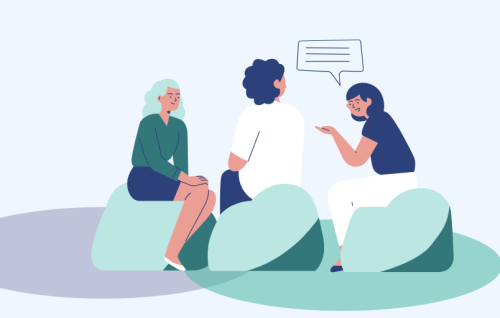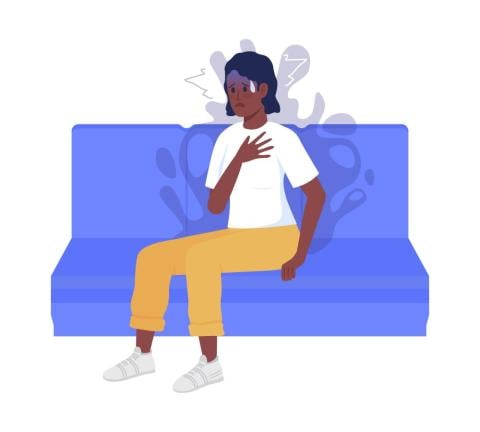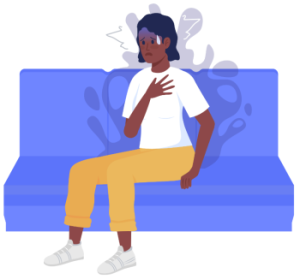
Are you interested in starting a support group? Below are tips and strategies on how to get your own support group started.
*Support groups can be a great addition to therapy or part of a prevention plan, but should not be a replacement for individual therapy. Always use caution when considering advice from an online source or support group, and if you are unsure, always ask your doctor or mental health provider.
What is a Support Group?
A support group is when individuals come together and share their personal stories and experiences about challenges they are facing and how they are dealing with them. A group's purpose is to support each member and help them feel that they are not alone.
Support groups are open to anyone, but are often focused on a specific topic (i.e., depression, PTSD, family, addiction, etc.) and are geared towards a specific audience. It's good to research and find what's best for you. Support groups can vary in size and structure, and can be in person or virtually. Some support groups can be led by the members, while others are led by trained facilitators.
Benefits of a Support Group
Sometimes it can feel as if we are the only person experiencing these things. Support groups can help individuals to feel less isolated and alone in what they are experiencing. Groups provide a safe, non-judgmental and confidential space for people to talk about their feelings.
Research support groups in your area or ask your mental health provider for a list of support groups you can join. Finding the right support group is similar to finding the right therapist; you might have to go to a few different meetings before you find one that's right for you.
Check out ADAA's Online Peer-to-Peer Communities or find a support group through ADAA's National Support Group Listing.
Getting Started — Tips and Strategies to Starting a Support Group
Research
First, research support groups in your area. You may have a specific support group you are wanting to create (or you may not), but searching available groups nearby will help you narrow down your support group's purpose and will give you a better understanding of your community's needs.
Choose a Topic
Support groups should focus on a specific topic(s) or a specific audience, that way the facilitator and participants know what to expect from the group. The group can have one topic (i.e. BDD, social anxiety, OCD, PTSD, etc.) or have a combination of these (i.e, individuals with OCD and anxiety disorders).
Participants
Determine who you want your support group members to be. Will it be open to anyone or will this be a women-only or a men-only group? Is the group open to both cis and trans participants or is it specifically for transgender people?
Your support group can be for individuals with a disorder, families and loved ones of an individual with a disorder, or the families and the individual together.
Another thing to consider is the age range of participants. Identify the age range by groupings: older adults (ages 50+), adults (ages 18+), young adults (ages 18–30), teens (ages 13–18), or kids (6-12), for example. Support group participants under 18 must have written consent from their legal guardian to participate in the group.
Facilitator
A facilitator is someone who leads or moderates the group. Support groups can be peer-led or led by a trained facilitator. A facilitator's responsibilities may include: leading discussions, creating a safe and respectful environment for all participants, monitoring ground rules, and serving as timekeeper.
If you want to participate in the support group you created, it may be easier if someone else is chosen to be the facilitator so that you can be fully present and participate in the meetings. Another option to consider is having two facilitators and rotating between them.
Meeting Structure
Will your meetings be free flowing or will there be a set agenda to follow? A set agenda has time limits on each section of the meeting that the facilitator would be timekeeping. Below is an example of a support group meeting:
- Welcome given by the facilitator
- Go over the objective of the meeting (identify the topic)
- Allocate time for the participants to discuss the meetings designated topic or assignment
- Discuss future topics or group goals
- The facilitator will wrap up the meeting by thanking participants and reminding them of next week's topic
Allowing members to choose meeting topics will allow them to feel ownership of the meeting and more a part of the group. Once topics have been chosen, it may be helpful to create a calendar with the allocated topics to hand out to members.
Is there a specific goal for the group (i.e. the Twelve Steps from Alcoholics Anonymous)? If there is a goal set for the group, set aside time during the meeting to go over the group goals and allow the participants to discuss how they are doing with those goals.
Other questions to consider when planning your meeting agenda: Will there be a Q&A section? Will there be time for informal socializing? Will there be an educational component to the group meetings, such as guest speakers or books related to the disorder?
Location & Timing
The support group can meet in person at a set location or via online meeting platforms such as Zoom or Google Hangouts and other online spaces. If you choose an online platform, consider its security features to ensure privacy.
How often will the group meet—once a week, once a month, twice a month, etc.? What time of day and day of the week will the meeting be? And how long will it last? Most support groups run between 45 to 90 minutes.
When deciding the scheduling of the group determine whether the group will run for a certain number of weeks or be ongoing. If it is an ongoing support group please refer to the first bullet point under 'Organization & Other Questions to Consider'.
Organization & Other Questions to Consider:
- Will the group be closed or open to new members? If closed, how often will it open to new members?
- Will there be a group confidentiality policy?
- Will the group adopt rules and delegate responsibilities?
- Will there be an attendance policy?
- Will there be a cost for participating?
Above all, it is most important to make sure that your support group has a safe, confidential and welcoming atmosphere. It may be helpful to explain what confidentiality means to all of the participants so that everyone has the same expectation of privacy. As the group grows, develop ground rules for the group (these can be created by the members). These rules will help establish boundaries, keep the order, and create a safe environment for all participants. The facilitator is responsible for monitoring ground rules.
Growing Your Support Group
You've gone through all the steps to create your support group, now all you need are people to participate! The question is, how many people should your support group have? That all depends how many people the facilitator is comfortable leading, but most groups have between 8-12 members. It may take a while to reach this number, but don't be discouraged if your group is small for the first few months. Finding core members takes time.
Some ways to grow your attendance:
- Find a mental health organization that will post your listing (Submit your support group to ADAA)
- Call local therapists in the region and ask them to spread the word
- See if local newspapers will do a free advertisement
- Post a free listing on www.meetup.com
- Post a free listing on Craigslist
Additional ADAA Resources
Infographics
Blogs
- ADAA’s Free Depression & Anxiety Peer-to-Peer Support Groups Offer Valuable Online Communities
- Understanding Group Therapy and Support Groups
Pages
- ADAA's Online Peer-to-Peer Communities
- ADAA's National Support Group Listing
- ADAA's Find Your Therapist Directory
Other Mental Health Support Group Resources

















